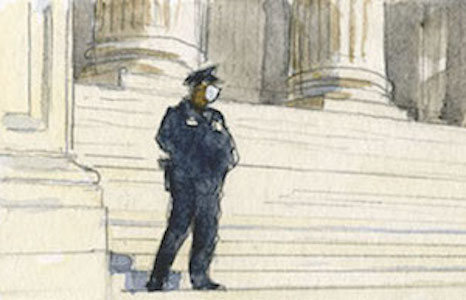Tuesday round-up


The ink is still drying on the Supreme Court’s opinions for the 2019-20 term, but court watchers are already looking ahead to the cases that will open next term. The court on Monday released its calendar of oral arguments for its October sitting, which will consist of 10 cases that initially had been scheduled for this spring but were postponed due to the COVID-19 pandemic. Amy Howe provides a run-down of all 10 cases in a story that first appeared at Howe on the Court. The October schedule indicates that the court likely will not hear argument in California v. Texas, the constitutional challenge to the Affordable Care Act, before November. Susannah Luthi reports for Politico that “[i]t’s still possible the court could hear the Obamacare case the week of Nov. 2, but it’s unlikely the court would take up such a politically charged case so close to the Nov. 3 election.”
Retrospective analysis of the recently ended term continues. At FiveThirtyEight, Amelia Thomson-DeVeaux looks at public-opinion polling on some of the biggest issues the court tackled and concludes that “though there were some fierce disagreements among the justices, the court’s final rulings were actually not very controversial at all — at least from the perspective of most Americans.” In the Atlantic, Jeffrey Rosen argues that Chief Justice John Roberts “decisively and impressively achieved his goal” of preserving the court’s institutional legitimacy, becoming in the process the most powerful chief justice since the New Deal era. Writing for Bloomberg, Noah Feldman goes even further and asserts that Roberts is “now the most influential chief justice since the great John Marshall, who held the job from 1801 to 1835.” Leah Litman, writing for Slate, interprets Roberts’ jurisprudence this term as rejecting attempts by conservative litigators and conservative lower courts to change the law too quickly.
Briefly:
- In the National Law Journal, Tony Mauro profiles an ultra-exclusive group within the elite club of Supreme Court clerks: “the handful of former law clerks whose children have gone on to clerk at the court.”
- Various commentators continue to reflect on the court’s approach to the separation of church and state. At the Human Rights at Home Blog, Jeremiah Ho interrogates the role of pluralism in the court’s three recent decisions expanding religious rights: Espinoza v. Montana Department of Revenue, Little Sisters of the Poor Saints Peter and Paul Home v. Pennsylvania and Our Lady of Guadalupe School v. Morrissey-Berru. At Stanford Law School’s faculty blog, Michael McConnell explains the Our Lady of Guadalupe ruling in a Q&A with Sharon Driscoll. Writing for RealClearReligion, Stephanie Taub and Allison Pope say the Our Lady of Guadalupe ruling was an important victory for religious institutions because, without it, “these organizations would have been subject to increased litigation and court scrutiny over the hiring of key personnel and may have been required to comply with employment laws, even when compliance would have contradicted their religious tenets or values.”
- At E&E News, Pamela King recaps the decisions on environmental issues the court handed down in the past year. King’s lede: “A Supreme Court term studded with blockbuster environmental cases has green groups celebrating and industry attorneys calculating the legal fallout.”
- Writing for the U.S. Chamber Litigation Center, Shay Dvoretzky and Jeffrey Johnson weigh in on the court’s ruling in Barr v. American Association of Political Consultants and its implications for businesses.
We rely on our readers to send us links for our round-up. If you have or know of a recent (published in the last two or three days) article, post, podcast or op-ed relating to the Supreme Court that you’d like us to consider for inclusion, please send it to roundup [at] scotusblog.com. Thank you!
Posted in Newsletters